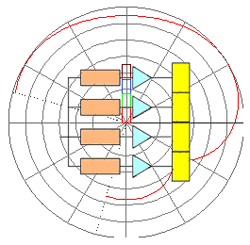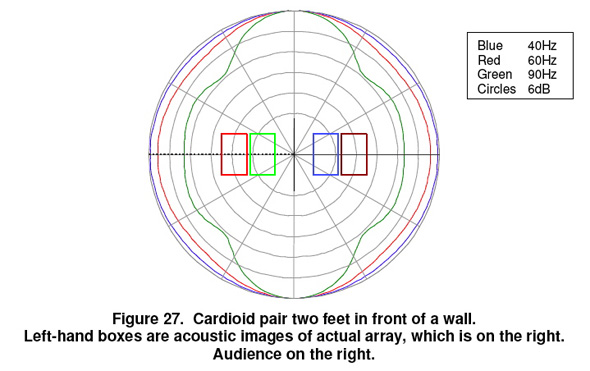
Effect of Nearby Surfaces
Gradient pairs do not function correctly when they are situated in front of walls or other reflecting surfaces.
Figure 27 shows what happens when our Xsub pair is placed two feet (60cm) in front of a wall.
The wall is shown by the vertical line in the center of the graph. The two woofer boxes on the left are virtual boxes—acoustic images created by the reflection in the wall.
The two boxes on the right are the actual woofers.
Reverberant Field Tonal Balance
Most subwoofer arrays become less directional at lower frequencies. Thus, as the frequency goes down, they send proportionately more of their output into the reverberant field of the venue.
This causes an excess of subbass (sometimes called “bass bloom”) in the reverberant field.
Unlike almost all other kinds of loudspeakers, gradient loudspeakers maintain pattern control down to the lowest frequencies. Thus, they can be helpful in applications where a full subbass experience is needed, but without too much reverberant low-frequency energy.
Element Drive Level and Woofer Count
In practical gradient arrays, it has been found that minimum rear radiation occurs when the output of the rear element (it is often called the “steering element”) is approximately 6dB less than that of the front element. This result is due to cabinet shape effects. In practical terms, this means that the number of rear woofers can be half of the number of front woofers.
8.3. Advanced Gradient Drive
Using delays to create directional patterns is an effective technique at low frequencies, but it does not take into account the effects of loudspeaker cabinet shapes on the sound waves. The result is that at the upper end of an array’s frequency range, its radiation pattern can deviate from the expected shape.
When front and rear loudspeakers are combined in a single cabinet, such as in EV’s XCS-312 cardioid subwoofer, it is possible to develop advanced drive processing methods that correct for these effects, so the loudspeaker maintains its specified directivity over its entire frequency range.
These drive systems use frequency-dependent delays (also called “all-pass filters”) to offset the effects of sound propagation around the cabinets.

